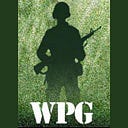The Warblog: The 2000 Yard Stare
By Dale A. Dye
Some sage said that one picture is worth a thousand words. There’s some dispute about who said it first, but I’ve got no doubt that whoever it was hit the proverbial nail right on the head. In fact, in my case one picture — like the one reproduced here — can prompt at least a
thousand words. I’ll try to stay under that count, but I’m moved to talk a bit about what the photo means to me as a Marine, a writer, and a filmmaker.
The painting was conceived by Time/Life Magazine war correspondent/artist Tom Lea during his experiences with the 1st Marine Division fighting the bloody battle for Peleliu in September 1944, during World War II. It depicts a war-weary Leatherneck that Lea saw after the fight on Bloody Nose Ridge, one of the Japanese forces’ most sternly defended strong points on that South Pacific island. In a brief caption, Lea describes his subject thusly: “His mind is numbed in battle, his jaw hung, and his eyes were like two black empty holes in his head.” Those words are certainly descriptive but they are also unnecessary, particularly to observers who have seen infantry combat. I’m one of those.
During my time at war in Southeast Asia, I saw a number of similar men, standing post-battle and merely looking at something only they could see. Their mind and spirit ravaged by close combat, perhaps not thinking at all, barely conscious in the standard meaning of that condition, or maybe just trying to deal with the fact that they’d survived. It’s been called “the thousand yard stare” and most combat veterans are familiar with it — first or second hand. Such images haunt me as a Marine because I understand from my own wartime experience they depict the brutality of combat and define the limits of endurance beyond which human beings are too often asked to go. Put this guy in a snow-spattered parka standing on some Korean hill; put him in camouflage standing in a jungle clearing with an M-16 on his shoulder, or make him a man wearing a Kevlar helmet dusted with desert sand and the effect would be the same. This is a a strong image, which says silently what war in general, and infantry close combat specifically can do to the human spirit.
Lea’s haunting work has stayed with me since the first time I saw it as a boy growing up after the end of World War II. I got a chance to visit Peleliu when I was doing research for the popular HBO mini-series “The Pacific” and crawling around those coral ridges where discarded and ignored combat detritus lay rusting, rotting and undisturbed by tourists, gave me a new-found respect for the men who fought there. No combat in any theater of war is ever easy or inconsequential to the people who have to endure it but Peleliu must have been a particularly exhausting and brutal experience. Afterward I interviewed several Marine veterans of Pacific campaigns. Those who fought on Peleliu mostly just took a deep breath and shook their heads. Peleliu was indescribable beyond simple terms like rugged, bloody and profane words I can’t quote here. I came away from that experience sobered and determined to the best of my ability to make the Peleliu episode of the mini-series as real as I could to reflect how different and difficult the fight must have been. I hope we did that. Certainly all of us involved in recreating the Peleliu fight for TV were dedicated to it and while we were filming, I carried a copy of Tom Lea’s painting to convey to all involved what we were trying to show.
That image was impetus to me as a writer when I was deciding on a setting for my second book in the Shake Davis series of adventure stories. Shake and his buddies — U.S. Navy Seals this time — were hunting for terrorists who were experimenting with a particular virulent form of biological warfare and it seemed to me that what they should face in such a world-threatening scenario would be interesting if it happened on Peleliu where so many of their military predecessors fought just such a determined foe. So I had Shake Davis and company chase their enemies through the ridges and jungles of Peleliu. At the end of a brutal final fight, Shake stands numbly gazing out over the Pacific. In my imagination he looked at that moment just like the shattered Marine in Tom Lea’s painting.
Marine officer Dale A. Dye rose through the ranks to retire as a captain after 21 years of service in war and peace. Following retirement from active duty in 1984, and upset with Hollywood’s treatment of the American military, he went to Hollywood and established Warriors, Inc., the preeminent military training and advisory service to the entertainment industry. Dye has worked on more than 50 movies and TV shows, including several Oscar- and Emmy-winning productions. He is a novelist, actor, director, and showbusiness innovator who wanders between Los Angeles and Lockhart, Texas.
Watch the HBO mini-series “The Pacific” Part 5: Sledge gets his first taste of combat on Peleliu. Grab Shake Davis #2, Peleliu File here.
Look for Dye’s new Shake Davis novel, Havana File, in May wherever books are sold. Until then . . . #LetsShakeItUp.
